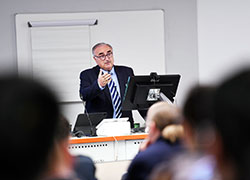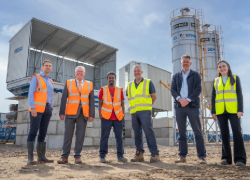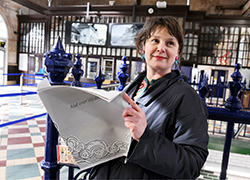Detecting the fat burning zone
When Meez Islam, a physical chemist at Teesside University, chanced upon his old Oxford University tutor, it was the start of a research collaboration lasting nearly a decade.
A new device has been developed to pinpoint the moment when a sweaty session down the gym finally starts to pay off, by detecting when the body has used up its supply of food energy and switches to breaking down fat instead.
The fat-burning breathalyser works by spectroscopically picking up tiny changes in the levels of the acetone molecule in people's breath, which is given off when the body starts to burn fat rather than food.
And one of the scientists behind the research, which has led to a commercial agreement between Oxford and Teesside universities, is Dr Meez Islam, a member of Teesside’s Technology Futures Institute.
Dr Islam’s research specialism is absorption spectroscopy and he has been a regular academic visitor to Oxford University since he bumped into Professor Gus Hancock, his erstwhile physical chemistry tutor, at a conference in 2002.
Professor Hancock’s Oxford group is internationally renowned for developing and applying a novel and highly sensitive spectroscopic technique called cavity enhanced absorption spectroscopy (CEAS).
Fat-burning breathalyser As well as the commercialisation of the new fat-burning breathalyser by Oxford Medical Diagnostics, a spin-out from Professor Hancock’s research group, the long-term collaboration has led to cutting-edge research by Dr Islam and his team at Teesside that has significant potential for a variety of applications.
Absorption spectroscopy is widely used in many fields – from finding out the composition of stars to measuring levels of air pollutants. CEAS makes absorption spectroscopy more sensitive by using an optical cavity formed by two highreflectivity dielectric mirrors to increase the path’s measurement length – making it possible to detect much smaller chemical concentrations.
‘A normal wall mirror reflects about 90% of the light falling on it, whilst a dielectric mirror may reflect more than 99.9%,’ explained Dr Islam. ‘An optical cavity formed by these mirrors allows light to be reflected about 1,000 times. This means we also gain a thousand-fold increase in sensitivity.
‘The work with Professor Hancock’s group has influenced my main research area at Teesside. I realised early on that these experiments were too expensive to be replicated at Teesside – so I had the idea of using high-intensity light-emitting diodes (LEDs) as the light source and a cheap spectrometer as the detector.
‘Although at the time it seemed a slightly crazy idea, Gus helped me develop a prototype – and it actually worked. I’ve since refined the technique at Teesside. It is generally known as LED broadband cavity-enhanced absorption spectroscopy (LED-BBCEAS).'
With support from Professor Zulfiqur Ali and the University Research Fund, Dr Islam has been able to perform some pioneering experiments that mean the technique can be applied to liquids as well as solids.
'I was fortunate to have an extremely capable PhD student, Nitin Seetohul, to work on it. We did very challenging experiments on a very modest budget – yet we’ve been able to demonstrate the first application of LED-BBCEAS to liquids.
‘Separately we have made the most sensitive liquid phase absorption measurement reported in academic research literature. And we’ve shown the first application of BBCEAS to a highperformance liquid chromatography system – one of the most widely used separation techniques in analytical science.
‘I’m proud that we’ve been able to do these cutting-edge experiments at Teesside, while getting our work published in the leading analytical chemistry journals. We have a paper that is one of the most downloaded papers within the Analyst journal so our work seems to be making an impact in this area.'
The BBCEAS experiments are ongoing and Dr Islam believes any analytical technique which uses absorption spectroscopy could benefit from BBCEAS application. ‘Currently we’re refining the technique to improve sensitivity,’ he says, ‘but we’re also trying to extend the measurement wavelength into the analytically important ultraviolet (UV) region by using UV LEDs and appropriate mirrors. Working with Professor Ali and his group, I am also applying BBCEAS to microfluidic devices and microplate readers.’
The applications are diverse. Breath testers have been in development for years, but the sensitivity of the new system means it can detect acetone and other analytes at sub-10 parts per million. ‘The technique could be used for noninvasive diagnosis and monitoring of diseases such as diabetes.’
Dr Islam is named as a co-inventor on the patent underpinning the device, which has been exclusively licensed to Oxford Medical Diagnostics. 'Ultimately we hope to develop a handheld device that a diabetic can breathe into, so they don’t have prick their finger for a blood sample to monitor their glucose levels. Much less pain, much less distressing.
 Teesside University hosts groundbreaking hydrogen conference
Teesside University hosts groundbreaking hydrogen conference University supporting development of new £1m concrete plant
University supporting development of new £1m concrete plant Academic’s artwork on display at Middlesbrough station
Academic’s artwork on display at Middlesbrough station